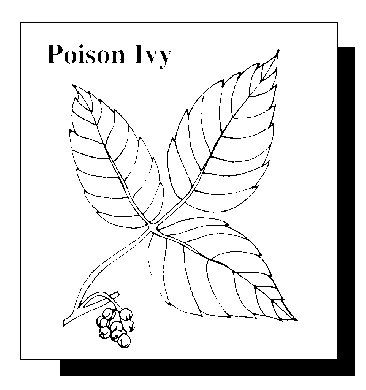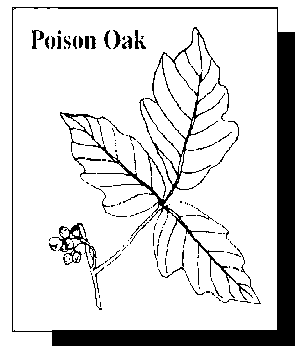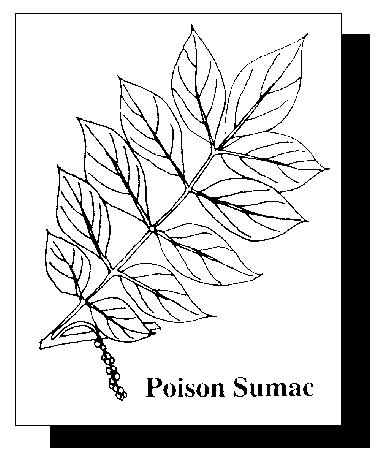Many
people are accidentally poisoned each year from contact with plants they did
not know were harmful. If they had known how to identify these plants, they
could have escaped some painful skin irritations. Note:
Click
on images to see larger view.
Poison
Ivy Poison
ivy is known by a number of local names because of its wide variation of appearance
in different locations. Some poison ivy has heavy, rough, woody vines. Others
are trailing shrubs that run on the ground, while others are erect, woody shrubs. Poison
ivy is known by a number of local names because of its wide variation of appearance
in different locations. Some poison ivy has heavy, rough, woody vines. Others
are trailing shrubs that run on the ground, while others are erect, woody shrubs.
The
leaf shape differs on different plants as well as on the same plant. One thing
remains the same: there are always three leaflets. Remember:
leaflets three, let it be.
Flowers
and fruit are always in clusters on slender stems that are attached to the
branches where the leaves come out. The berries have a white, waxy appearance.
After the leaves have shed, the waxy white berries are an easy way to identify
poison ivy. Some poison ivy fruit looks like a peeled orange, others are hairy,
and some are smooth.
Poison
Oak Oakleaf
ivy has leaflets similar to white oak leaves. It is also known as poison oak.
This form of ivy usually does not climb as a vine but is found as a low-growing
shrub. Common poison ivy grows in many places as a shrub. It also grows as
a vine in some localities. Oakleaf
ivy has leaflets similar to white oak leaves. It is also known as poison oak.
This form of ivy usually does not climb as a vine but is found as a low-growing
shrub. Common poison ivy grows in many places as a shrub. It also grows as
a vine in some localities.
Other
vines are sometimes confused with poison ivy. These plants are Virginia creeper
and some forms of Boston ivy. Neither of these vines is poisonous. You can
recognize Virginia creeper by its five leaflets radiating from one point of
attachment.(Leaves
of five, let it thrive.)Boston
ivy, with three leaflets, is hard to tell from its poisonous brother. The best
policy to follow is to avoid plants and vines that look like poison ivy.
Poison
Sumac Poison
sumac, a third member of the poison ivy family, is different because it usually
is a shrub or even a small tree up to 25 feet tall. The leaves are 7 to 15
inches long and have 7 to 13 leaflets attached to a central stem. The berry
of poison sumac is also ivory or white and formed in clusters. Poison sumac
is usually found in permanently wet swamps or moist bottomlands. It is not
as abundant as its two poisonous relatives -- poison ivy and poison oak. Poison
sumac, a third member of the poison ivy family, is different because it usually
is a shrub or even a small tree up to 25 feet tall. The leaves are 7 to 15
inches long and have 7 to 13 leaflets attached to a central stem. The berry
of poison sumac is also ivory or white and formed in clusters. Poison sumac
is usually found in permanently wet swamps or moist bottomlands. It is not
as abundant as its two poisonous relatives -- poison ivy and poison oak.
|